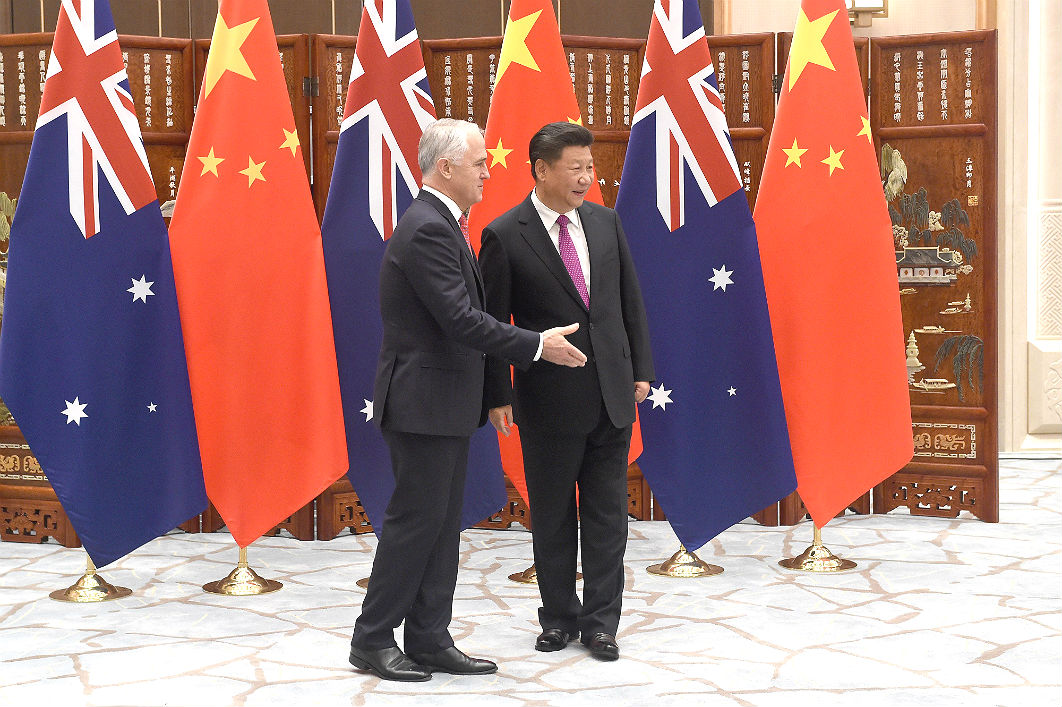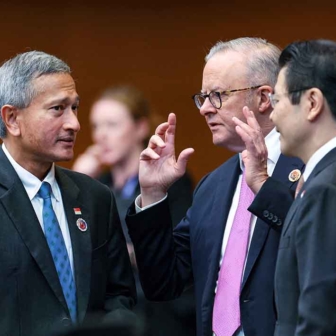Who would have imagined that educational cooperation between Australia and China would generate so many headlines in 2017?
In March, Australian academic Feng Chongyi was prevented from leaving Guangzhou and subjected to interrogation; the matter reached the offices of the Australian prime minister and the Chinese premier. In a number of separate incidents, Australian university lecturers have been denounced on Chinese social media and the web for offending the patriotic sensibilities of their students. And in mid August, an intimidating convoy of luxury sedans heading for the Indian government mission in Sydney slowly toured the campuses of UTS and the University of Sydney bearing a slogan drawn from a popular Chinese movie: “Anyone who offends China will be killed…”
It does not take much to offend China. One offending lecturer at the University of Sydney used a standard-issue map in class that varied from official Chinese government maps of the contested China–India border. Another lecturer pilloried on social media displayed a sign in English and Chinese in an ANU classroom that read, “I will not tolerate students who cheat.” A third offending lecturer, based at the University of Newcastle, used a third-party document listing Hong Kong and Taiwan separately from China. In this case the Chinese government intervened directly. The campus arm of the official Chinese Students and Scholars Association is reported to have protested, while the Chinese consulate contacted the university to register its displeasure over the lecturer’s teaching.
In China, punishment is meted out daily to lecturers who offend the Communist Party in the classroom. Authorities encourage students to report on their lecturers if they say anything out of line with official policy. The effect is chilling. In teaching history, for example, little can be said in a university seminar on modern history that can’t be found inside a tenth-grade textbook. Beyond history, the practice dampens serious scholarship in the humanities and social sciences.
Punishment is now being meted out in Australia. As the former Fairfax correspondent John Garnaut recently noted, scholarly intimidation is being imported into Australia under official Communist Party licence as “red hot” patriotism. Given the scale of Chinese student enrolments, the dependence of university budgets on those enrolments, and the desire to maintain goodwill in Australian and Chinese international education circles, the Party’s directives could have a dampening effect on critically informed university education in Australia.
The same can be said globally. In August, Cambridge University Press acceded to a request from Chinese censors to remove over 300 articles from the version of its online China Quarterly journal archive accessible to scholars in China, and eventually restored the offending pieces only after international pressure was brought to bear. More worryingly, China legal expert Glenn Tiffert recently revealed that the major Chinese-language archival sources to which university libraries subscribe at great expense are being retrospectively censored by the removal from back issues of content that no longer complies with current political sensibilities in Beijing. Once a database has been corrupted in this way, it can no longer be trusted as a scholarly resource.
While they may make headlines from one day to the next, Beijing’s censorious behaviour and underhand censorship have had little impact overseas outside the humanities and social sciences. The bulk of research engagement between Australian and Chinese universities is not in history or sociology but in science and technology, where universities are partnering at scale. Is Beijing’s behaviour likely to make headlines in the sciences as well?
Between them, Australian universities host hundreds of collaborative research programs in partnership with Chinese universities and research agencies. Where the university meets the city, considerable investments are at stake. In April 2016, the University of New South Wales announced a $100 million investment from China in support of a new “Torch” science and technology innovation precinct. In August 2017, RMIT University and the University of Melbourne announced a joint agreement with the Australia–China Association of Scientists and Entrepreneurs to build a science innovation hub in the city of Melbourne, funded with up to $80 million over three years by the Suzhou High-Tech Venture Capital Group.
Some of these collaborations have defence applications and are presumably monitored on that account. But the majority of the partnerships support good science, smart innovation and sorely needed commercialisation. What’s not to like?
In fact, we don’t know. Australian universities are sailing into uncharted waters when they venture into major research collaborations with institutions and systems that do not share their commitment to liberal values and free and open critical inquiry. It is not clear that they are equipped to manage the risks that can arise when they align their research, teaching and corporate missions with universities in other national systems that hold academic freedom in low regard. Faced with these opportunities, the current corporate model of university governance is systematically inclined to go for alignment, and to set aside values that were once considered a liberal university’s greatest assets. It’s on this point of values that the sciences and the humanities meet.
For two decades now, Australia’s relations with China have been conducted through an informal compact under which each side agrees to leave its values at the door. Australians value freedom, equality and the rule of law. China’s government values proletarian dictatorship, authoritarian hierarchy, and rule by the Party rather than by law. Under the compact, Australia and China agree to respect and to set aside the other’s professed values in order to focus on shared interests in expanding trade and investment.
The compact works well for miners, farmers, investors, lawyers, architects, tourism operators and other businesspeople who go about their business trading in goods and services with China, as they do with other countries that do not share the same values. Unlike mining companies or agribusinesses, however, universities deal in values and one of their core values is academic freedom.
Australian universities profess to uphold academic freedom in their charters, and are routinely called on to do so in everyday practice. China’s education and research systems are arms of a party-state that is openly hostile to the idea of academic freedom. So, as a rule, Chinese universities do not spell out their commitment to free and open critical inquiry. These differences are not trivial when university partners from Australia and China come together to transact agreements for mutual benefit.
As the American legal philosopher Ronald Dworkin has written, academic freedom carries duties, including the “duty to speak out for what one believes to be true” and an accompanying recognition that it is fundamentally “wrong to remain silent” in the face of assaults on freedom. Australian universities that leave their values at the door arguably neglect their duties and place their reputations at risk.
In the past these risks were negligible. But in transitional moments such as the present, when China is asserting its Leninist values globally and the United States appears to be retreating into its shell, risks to the freedoms that we take for granted are real, pressing and substantial. Are Australian universities capable of assessing and managing these risks?
The corporate university
Writing in the 1950s on the development of academic freedom from twelfth-century Europe to mid-twentieth-century America, the historian Richard Hofstadter associated the ideal with the struggles of the independent scholar in the face of challenges from ecclesiastical and state authority. Today, the legendary Western ideal of the solitary mendicant scholar, free to roam without interference and speak truth to prelate and prince, sits uneasily alongside the immense resources invested in contemporary universities charged with driving innovation, industry and business in highly competitive national and international markets.
More recent scholarship has drawn attention to a different set of challenges to academic freedom arising from the corporatisation of the university itself. In The Lost Soul of Higher Education, the historian Ellen Schrecker presents a sustained critique of the “assault on academic freedom” presented by the corporatisation of the university in our time. Vice-chancellors and presidents apply market principles to university management, expand administrative budgets and introduce business-friendly priorities into the life of the university, expand the casual workforce, and promote competition for resources among individual scholars and competition for status among institutions. Taken together, Schrecker argues, these incremental developments have transformed the mission of the university, reduced its autonomy, and limited the time and inclination of individual academics to participate in the collegial decisions bearing on appointments, curricula, research and peer review that underpin the everyday practices of academic freedom and independence.
Whether or not we credit these developments with limiting academic freedom, observers of Australia’s higher education system would generally concede that Australia moved earlier and more uniformly towards adopting the corporate methods of the enterprise university than the American higher education system did. Faculty governance is no longer practised to any meaningful degree. And yet in Australia, unlike America, it is by no means clear that the corporate university poses graver threats to traditional freedoms than the system that preceded it.
In 1974, the Whitlam government’s abolition of tuition fees made universities uniformly and wholly dependent on Commonwealth funding for operating and capital expenditure for over a decade. From the mid 1970s to the late 1980s, universities were made to feel their dependence on Commonwealth funding through a process of attrition known as “steady state” funding, which reduced their budgets to a parlous state by the end of the decade. Commonwealth funding failed to keep pace with operating expenses. Capital stock deteriorated as older buildings were not maintained and new construction was postponed indefinitely.
Dependence on Commonwealth funding made universities especially vulnerable to managerial innovation. In the mid 1980s, the national economy was harnessed to the fortunes of the world economy following tariff reductions and the floating of the dollar. Vice-chancellors and university councils anticipated further shocks, including reductions in Commonwealth funding and greater demands for accountability to government agencies in relation to their enrolments, the courses they offered, their staff performance and their financial accounting. Peter Karmel at the Australian National University and David Penington at the University of Melbourne began to develop their own internal change agendas that anticipated key features of what was to be called the Dawkins model.
In 1987, John Dawkins took advantage of the federal government’s dominance of the system to reduce dependence on federal funding and at the same time sharpen the tools of public administration to reshape the provision of higher education in Australia. With the introduction of the unified national system, followed by a decade of institutional amalgamations and quality-assurance rounds, virtually every Australian university had come to embrace the enterprise model of corporate governance.
After Dawkins, the federal government shifted from rowing the boat to steering it, as the saying goes. It exchanged direct control for a dashboard of buttons and levers with which to shape higher education and research. It made improved corporate governance a condition for university entry to the unified national system. Among other things, improved governance involved redefining the role of vice-chancellor from primus inter pares to CEO of the university enterprise, and led to reduced staff and student representation and greater business and government representation on governing university councils.
In one sense, Australian universities have prospered under these reforms. But they came at the cost of transferring decision-making powers over curricula and research from participatory department and faculty committees to line management. Academic personnel policies were redrafted to align the performance of individual academics with overarching corporate missions, translating corporate strategic goals into individual academic targets covering research, education, scholarship and engagement. Today, university managers adjust their internal reward and punishment mechanisms to lift their university’s standings in global rankings, to hold academics accountable for burnishing the university’s brand in public correspondence, and to encourage academic participation in formally structured engagement with corporate end-users and international cooperation in research and teaching.
Here I would draw attention to one incidental effect of corporatisation that surfaces at the point where Australian universities align their strategies and partnerships with universities overseas that do not share respect for academic freedom or tolerate the wider liberties in which this freedom is nested. The convergence of strategic planning styles and line-management methodologies in China and the West masks the ultimately non-convertibility of the values of the liberal university and the values underpinning the Chinese university system. When corporate managers do deals without regard to values, they place those values at risk.
China
Domestically, higher education is one of China’s many success stories. Over the past three decades, the national tertiary participation rate has risen from under 1 per cent to around 25 per cent of the current age cohort, in a population one-third larger today than it was three decades ago.
China’s achievement can be attributed in part to a model of higher education that Simon Marginson has termed “The Confucian Model,” a term referring to national university systems extending from the People’s Republic of China to Hong Kong, Taiwan, Singapore, Japan, Korea and Vietnam, countries that have all been influenced by Confucian educational traditions, in which the state plays a number of critically important roles.
As a rule, systems that hold higher education and research accountable to the principles, goals and needs of the national state are prone to state interference in their executive autonomy, academic discovery and innovation. Still, the degree of state interference varies from one nation to another. The Confucian hierarchical model of education found in Singapore, Japan and South Korea makes provision for academic freedom commensurable with the greater or lesser degrees of freedom tolerated in each country, including freedom of expression and of the press, and freedom of religion and of assembly. China eschews all such freedoms and shows commensurably little respect for the principles derived from them, including academic freedom. There, the convergence of Confucian and Leninist models of strategic management presents challenges for free and open critical inquiry of the highest order.
The strategies through which the Chinese Communist Party and the Chinese government guide and control teaching, research and publication in higher education are embedded not in the principles of civic life East or West, but in strategies for waging war. The higher education sector is a “forward battlefield” in the conflict between Chinese communism and the values of a liberal education, according to 2015 State Council guidelines for higher education, and lecturers have the job of “consolidating a common ideological basis for the united struggle of the entire Party, the entire country and all the people.”
At the institutional level, individual academics are held accountable to university and national strategies through their university’s performance appraisal system, as in Australia. China’s academic personnel appraisal system appears to have been adapted in part from the Australian model, showcased through twinning programs matching Chinese universities with Australian higher education providers. In China, it is employed to measure compliance with Communist Party ideology and policy in joining battle with “harmful ideas.” The education ministry’s guidelines on academic personnel performance appraisal issued in August 2016 include measuring staff compliance with “the basic line of the Party” in their teaching. Academics who tolerate “the illegal spread of harmful ideas and expressions in the classroom will be dealt with severely according to regulation and law.”
The “harmful ideas and expressions” banished from university classrooms were set out in another Party communiqué issued in April 2013, and forwarded to university presidents and Party secretaries as a prescribed list of “seven prohibitions” governing university teaching and research. They include bread-and-butter topics in the liberal humanities such as constitutional democracy, civil society, economic liberalisation, freedom of the press, historical critiques of the Communist Party, challenges to socialism with Chinese characteristics, and discussion of “universal values” (local code for human rights and freedoms, including academic freedom). Not only are these topics banned from the classroom and the seminar. The communiqué banning them was designated a secret state document, partly out of habit, partly to avoid embarrassing overseas university partners.
Significantly, in December 2016 the Chinese president Xi Jinping went further to extend Party control beyond the humanities disciplines into the sciences. All science, according to the president’s office, is based on Marx’s scientific socialism. All science is on the battlefront. Those wishing to engage in science and technology teaching and research “must become firm believers in the core values of socialism.” No classes on campus are to escape political indoctrination and all who teach in them are to be tested for political compliance.
Directives such as these, designed to “strengthen management of the ideological battlefield,” are applied vigorously in all of China’s higher education institutions, with the exception of a few exemplary programs set up to impress foreigners at a handful of prestigious universities. In most of China’s 2400 universities, serious scholars revert to practices once favoured by medieval European philosophers faced with the ecclesiastical authority of the Roman Catholic Church. Some get on with their studies quietly, ignoring restrictions as best they can, without publishing or teaching anything that would directly challenge the authorities. Others defer to the right of higher authorities to correct their errors and oversights when they publish their research findings. Some seek refuge in one of a number of less restrictive urban jurisdictions where a particular university president or local Party secretary is known to provide protection from overweening central authority — assuming, that is, they are permitted to transfer their personal “dossiers” from one jurisdiction to another, which is often forbidden. In a country where state and ideological authority are one and the same at every level of government, interstitial spaces allowing scholarly refuge are relatively few compared with those in medieval and early modern Europe.
What is to be done?
An iconic moment in recognising the independent scholar’s right to move between towns, cities and states in search of political refuge in medieval Europe was the Constitutio Habita declaration of Bologna University in the mid-twelfth century. It is remembered today chiefly because European university presidents cited it as precedent when they met in Bologna in 1988 to sign a continental charter of academic principles, Magna Charta Universitatum. The 1988 Charta was a forward-looking document laying out the “principles of academic freedom and institutional autonomy as a guideline for good governance and self-understanding of universities in the future.” In the following year, the Charta helped to guide and to govern mergers and transitions among East European and West European universities following the collapse of the Berlin Wall.
One course of action would be to encourage more Australian universities to sign on to the Magna Charta Universitatum and to encourage prospective Chinese partners to become signatories on the understanding that they will profess and abide by the principles set out there. To date, four universities in China have signed — Peking, Nankai, Tongji and Wuhan — and eight Australian universities have done so. Australian universities could opt to give preference to research and teaching partnerships with universities that are prepared to sign.
Another approach would be to call out compromising behaviour on the part of Australian universities, and to talk more frankly about what the Chinese government is saying and doing in the field of higher education. We do China a courtesy by reading and translating what Party and government agencies are saying in their own language and to their own people, rather than repeating ill-founded assumptions advanced by retired Australian political leaders or senior university executives. More importantly, we do our Chinese colleagues in Australia and in China a disservice by not accepting the obligation to speak up about these matters.
Third, Australian universities could deploy the tools and drivers that corporate universities themselves employ to enhance their status and promote their services. One readily available set of tools is competitive global rankings. The entry of Chinese universities into the top echelons of published league tables, Oxford University’s Rana Mitter observes, suggests that academic freedom no longer matters for university standing. It could equally be read as an indictment of ranking systems that make no provision in their measurement indicators for free and open critical inquiry in the humanities and social sciences. This omission could be remedied by encouraging ranking agencies to introduce a minimal commitment to academic freedom as a threshold for entry onto competitive league tables, and to devise a workable measure of the exercise of academic freedom in each national system and university that crosses the threshold. Global rankings could then drive reforms favouring freedom through the competitive market mechanisms that currently stifle them.
A fourth intervention would be to limit the influence of external donors in shaping university appointments and research centres. Given the value differences separating our national higher education systems, Australian universities dealing with China face unprecedented pressures to meet the expectations of external donors and partners wishing to shape their research and teaching activities. Risks to academic freedom are magnified when university executives place the prospect of promising opportunities, big money and long-term strategic partnerships with Chinese entities ahead of traditional academic values. One remedy would be to invite an overarching body, such as Universities Australia, to develop and promote a best-practice guide for accepting and managing donor funds. This would ensure that their sources and origins are clearly documented, that donors present minimal risk to the standing of the university, and that firewalls are erected separating donor engagement from the selection of academic staff and research and teaching projects.
A fifth would be to require all existing centres funded from Chinese sources to demonstrate their commitment to the liberal values and academic freedoms that underpin the Australian higher education system. The entry of Confucius Institutes onto Australian campuses — twelve at last count, funded through China’s education ministry — offers a pointed illustration of the challenges the corporate university presents for academic freedom in international engagements. These innocuous entities play almost no role in formal education or cutting-edge research and yet they are considered important for international collaboration.
The reason is simple. To Chinese authorities, Australian universities’ disregard for the principles of academic freedom and autonomy in allowing the establishment of Confucius Institutes marks a breach in the battlefront with Western liberal values. As a rule, host universities have little say in the selection of Chinese staff, who are subject in Australia to the guidelines and restrictions on academics that apply within China. Their curricula and teaching materials are censored at the margins to pass the test of approved “battlefront” scholarship, and their directors are expected to play a gatekeeping role in preventing the circulation of materials in Australia that Chinese government authorities deem offensive — basically, the bread and butter of a liberal arts education. In short, they establish the moral equivalence of the principles governing the Australian and Chinese higher education systems. Having agreed that all values are relative, Australian universities are welcome to pursue collaborative research and education opportunities with Chinese institutions in science disciplines on a scale that far outstrips anything a Confucius Institute could possibly match. Their innocuousness is a measure of their success.
In bringing values more clearly into view, moving them from the doorway and putting them on the table, as it were, the aim should not be to impose them on others but to impose them on ourselves — to remind Australians of who we are and what we believe and where we draw the line. International engagements vital for the future development of higher education in Australia should not be allowed to place at risk the values that mark the university as an institution. The humanities and sciences are in this together. •
This essay, which first appeared in the Australian Financial Review, is an abbreviated version of the Annual Academy Lecture delivered in Melbourne on 15 November 2016 as part of the 47th Annual Symposium of the Australian Academy of the Humanities, “Asia Australia: Transnational Connections.” The full text appears in Humanities Australia, No. 8, September 2017.




